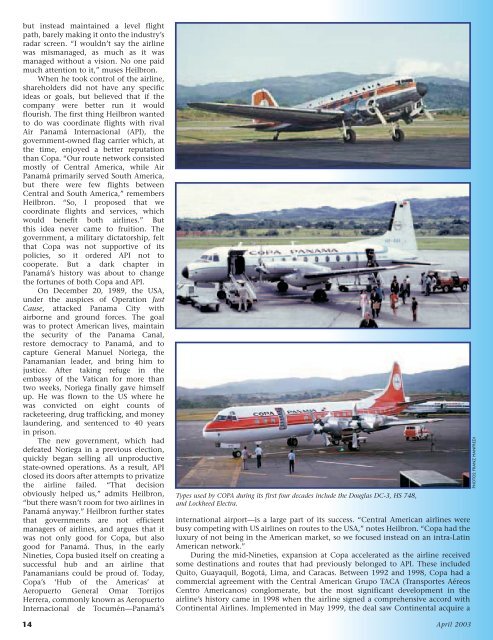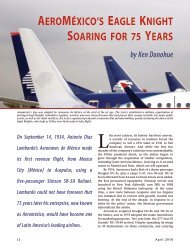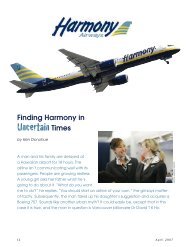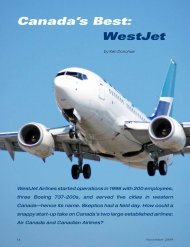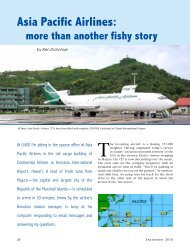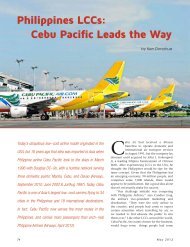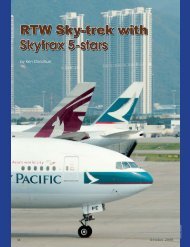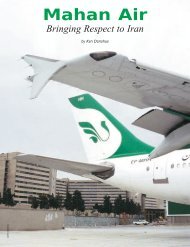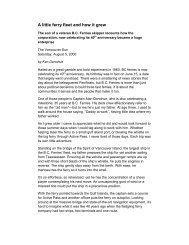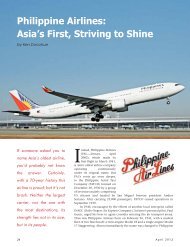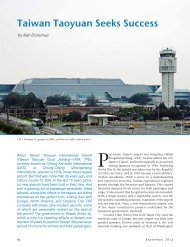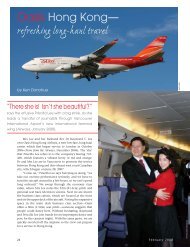Copa Airlines - Ken Donohue
Copa Airlines - Ken Donohue
Copa Airlines - Ken Donohue
Create successful ePaper yourself
Turn your PDF publications into a flip-book with our unique Google optimized e-Paper software.
ut instead maintained a level flight<br />
path, barely making it onto the industry’s<br />
radar screen. “I wouldn’t say the airline<br />
was mismanaged, as much as it was<br />
managed without a vision. No one paid<br />
much attention to it,” muses Heilbron.<br />
When he took control of the airline,<br />
shareholders did not have any specific<br />
ideas or goals, but believed that if the<br />
company were better run it would<br />
flourish. The first thing Heilbron wanted<br />
to do was coordinate flights with rival<br />
Air Panamá Internacional (API), the<br />
government-owned flag carrier which, at<br />
the time, enjoyed a better reputation<br />
than <strong>Copa</strong>. “Our route network consisted<br />
mostly of Central America, while Air<br />
Panamá primarily served South America,<br />
but there were few flights between<br />
Central and South America,” remembers<br />
Heilbron. “So, I proposed that we<br />
coordinate flights and services, which<br />
would benefit both airlines.” But<br />
this idea never came to fruition. The<br />
government, a military dictatorship, felt<br />
that <strong>Copa</strong> was not supportive of its<br />
policies, so it ordered API not to<br />
cooperate. But a dark chapter in<br />
Panamá’s history was about to change<br />
the fortunes of both <strong>Copa</strong> and API.<br />
On December 20, 1989, the USA,<br />
under the auspices of Operation Just<br />
Cause, attacked Panama City with<br />
airborne and ground forces. The goal<br />
was to protect American lives, maintain<br />
the security of the Panama Canal,<br />
restore democracy to Panamá, and to<br />
capture General Manuel Noriega, the<br />
Panamanian leader, and bring him to<br />
justice. After taking refuge in the<br />
embassy of the Vatican for more than<br />
two weeks, Noriega finally gave himself<br />
up. He was flown to the US where he<br />
was convicted on eight counts of<br />
racketeering, drug trafficking, and money<br />
laundering, and sentenced to 40 years<br />
in prison.<br />
The new government, which had<br />
defeated Noriega in a previous election,<br />
quickly began selling all unproductive<br />
state-owned operations. As a result, API<br />
closed its doors after attempts to privatize<br />
the airline failed. “That decision<br />
obviously helped us,” admits Heilbron,<br />
“but there wasn’t room for two airlines in<br />
Panamá anyway.” Heilbron further states<br />
that governments are not efficient<br />
managers of airlines, and argues that it<br />
was not only good for <strong>Copa</strong>, but also<br />
good for Panamá. Thus, in the early<br />
Nineties, <strong>Copa</strong> busied itself on creating a<br />
successful hub and an airline that<br />
Panamanians could be proud of. Today,<br />
<strong>Copa</strong>’s ‘Hub of the Americas’ at<br />
Aeropuerto General Omar Torrijos<br />
Herrera, commonly known as Aeropuerto<br />
Internacional de Tocumén—Panamá’s<br />
Types used by COPA during its first four decades include the Douglas DC-3, HS 748,<br />
and Lockheed Electra.<br />
international airport—is a large part of its success. “Central American airlines were<br />
busy competing with US airlines on routes to the USA,” notes Heilbron. “<strong>Copa</strong> had the<br />
luxury of not being in the American market, so we focused instead on an intra-Latin<br />
American network.”<br />
During the mid-Nineties, expansion at <strong>Copa</strong> accelerated as the airline received<br />
some destinations and routes that had previously belonged to API. These included<br />
Quito, Guayaquil, Bogotá, Lima, and Caracas. Between 1992 and 1998, <strong>Copa</strong> had a<br />
commercial agreement with the Central American Grupo TACA (Transportes Aéreos<br />
Centro Americanos) conglomerate, but the most significant development in the<br />
airline’s history came in 1998 when the airline signed a comprehensive accord with<br />
Continental <strong>Airlines</strong>. Implemented in May 1999, the deal saw Continental acquire a<br />
PHOTOS: FRANZ MANFREDI<br />
14 April 2003


